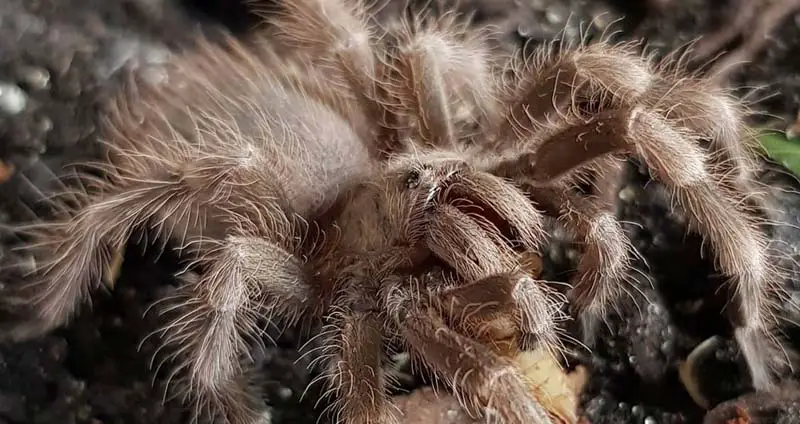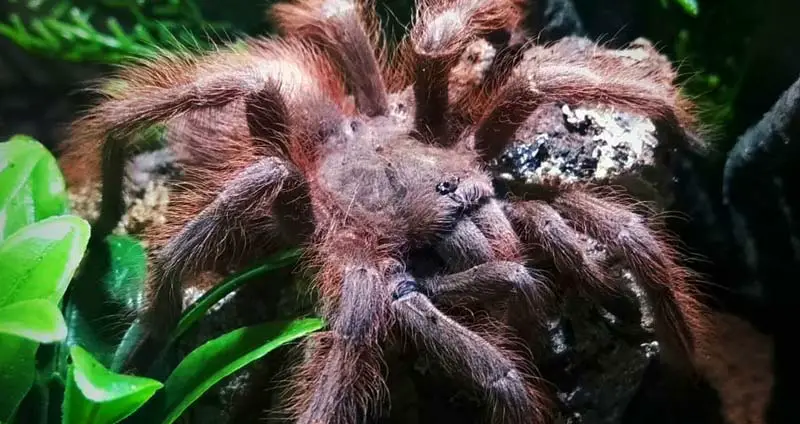Nhandu tripepii, also known as the Brazilian Blonde Tarantula, is an extremely bushy and unique tarantula species.
Not only does this tarantula have a great appearance, but it also tends to be quite friendly, hardy, and easy to care for. A great combination of traits!
If you’re thinking about purchasing a Nhandu tripepii to add to your collection, there’s a few specific things that you should know about it. Read on to learn about its diet, enclosure, and general care requirements.
Table of Contents
Nhandu tripepii Care Sheet
| Common Name |
Brazilian Blonde |
| Species Type | New world terrestrial |
| Habitat | Indigenous to Brazil in areas with high temperatures and humidity year-round. |
| Growth Rate | Medium growth rate, taking several years to reach maturity. |
| Adult Size | Females reach about 7″ in legspan, while males measure slightly smaller. |
| Lifespan | Females often live up to 11 years, while males only live up to 5. |
| Enclosure | The enclosure should be longer and wider than it is tall, with plenty of floor space. Several inches of substrate should be present to allow for burrowing. A sizable hide and water dish should also be included. |
| Temp/Humidity | 75°F to 80°F with about 65% to 75% humidity. |
| Diet | Great eater that can eat around 7 adult crickets weekly or 2 dubia roaches. Almost never rejects food. |
| Temperament | Some owners report that their specimen is relatively calm but can be nervous and skittish. Others note that theirs never throws up threat poses or flicks hairs and just sits around. |
| Experience Level | Beginner – A very hardy tarantula that spends a lot of time out in the open and isn’t typically aggressive. Some caution should be taken, though, especially for new keepers. |
| Average Cost | Slings ~ $40, Males ~ $75, Females ~ $100+ |
Nhandu tripepii Appearance
The first thing that you’ll notice when looking at this tarantula is that it’s covered in very long setae all over its body. This gives it a fuzzy appearance that’s only rivaled by a few tarantulas, like Brachypelma albopilousm.
These long setae are pink and cover the tarantula’s brown body, making it appear more pink.
In terms of body style, this could be described as a stock tarantula. Its legs are long yet thick, and the same thing could be said about its carapace and abdomen.
N. tripepii is a fairly large tarantula, too, with a legspan capping out at about 7″ for females and slightly less for males. They reach this full size at an average pace, which is surprising given its lifespan.
These tarantulas are only expected to live to about 11 years (5 years for males). So, once they reach maturity, they don’t have very long to live.

Nhandu tripepii Temperament
Although there are trends among different tarantula species in regards to their temperaments, every single tarantula is different, so it’s difficult to give blanket statements for temperament.
This species is no exception!
To begin with, Nhandu tripepii is a new world tarantula, a type of tarantula that’s known for its laid-back personality, lack of aggression, and preference to flee from danger as opposed to fighting it.
Some owners absolute agree with this classification, comparing their tarantula to a pet rock — extremely docile, never throwing up threat poses, and sitting around doing nothing.
Other owners, though, describe their N. tripepii as skittish, nervous, and kind of finicky. Not aggressive, just not as nice and friendly as others.
Therefore, this tarantula is definitely more of a “gamble”, if you can call it that. You’ll never be sure what you’re going to get until you get it.
What seems to be common, however, is that this species will get into “moods”. They will spend large amounts of time rearranging their enclosures or burrowing, then they’ll spend just as much time doing absolutely nothing.
If aggressive tarantulas turn you off, don’t worry. Nhandu tripepii doesn’t possess venom and virtually never bites. Instead, it possesses urticating hairs that it can flick at threats. Flicking hairs doesn’t seem to be common either, though.
Housing Nhandu tripepii
Before bringing home this tarantula, you need to make sure that you’re meeting all of its environment needs through an optimal enclosure.
Fortunately, it isn’t difficult to house N. tripepii. All that they require is a good terrarium, a few essential supplies, and a steady internal climate.
Optimal Enclosure
It should be noted that this is a terrestrial tarantula species with a strong desire to burrow. Because of this, supplying them with a standard terrestrial tarantula enclosure is essential.
What does this entail? Not much!
Terrestrial enclosures mainly focus on providing plenty of floor space for a tarantula to walk around on and burrow into. Additionally, it provides several ground-level hiding places since terrestrial tarantulas rarely climb.
The absolute best enclosure will have great cross-ventilation, accessibility, visibility, floor space, and security. For a tarantula of this size (7 inches), it needs to be plenty large enough.
Two recommended enclosures for this species are the Exo Terra 18″ × 18″ × 12″ terrarium and the Repti Zoo 20″ x 12″ x 10″ enclosure. Both are great enclosures for this species and will comfortably house an adult.
Enclosure Decorations
It isn’t enough to just buy a great enclosure, though. The inside needs to be optimally decorated as well!
To do this, you’ll need to supply your tarantula with a few essential supplies.
First and foremost, you absolutely need to layer about 6 inches of moisture-retaining substrate along the bottom of the enclosure. Not only does this provide a medium for burrowing, but it also promotes cleanliness and humidity retention.
For this, coconut fiber substrate is all you need. Nothing fancy.
On top of this substrate, a tarantula hide should also be included. This helps to make your Nhandu tripepii feel calm and safe — an especially important feature if your spider is particularly nervous!
Next, you can’t forget the ever-important water dish!
Tarantulas not only drink water, but the water dish also works to keep humidity levels within the enclosure consistent. Be sure to regularly clean and refill the dish, though, as tarantulas are very messy.
After you add those essentials, you can get a bit creative. Small rocks and fake plants round out the enclosure and provide a more diverse environment for N. tripepii.

Enclosure Temperature/Humidity
This tarantula species is endemic to Brazil. More specifically, its native environment is hot and humid almost year-round.
Because of this, their enclosure should closely mimic these conditions.
The optimal temperature range for Nhandu tripepii is around 75°F to 80°F, which is near room temperature for most people. So, luckily, supplemental heating isn’t required in most cases.
If your house regularly drops below this range, though, you may need to use either a space heater or a gentle heat lamp that doesn’t emit light.
In fact, the no light aspect of the lamp is very important. This species is particularly photosensitive and is negatively effected by lots of light exposure.
For humidity, aim for between 65% and 75% humidity. Maintaining this is very simple.
Simply keep the water dish filled at all times and mist one side of the enclosure with water about 3 times per week. When misting, don’t spray the tarantula, and don’t saturate the substrate, either.
It’s recommended that you use a thermometer/hygrometer to monitor temperature and humidity of the enclosure so that you can make small adjustments as needed.
Diet
This tarantula grows to be quite large, but it doesn’t have a very long lifespan.
So, it’s in your best interest to feed it the best diet possible so that it can grow as fast as possible. Doing this isn’t difficult.
As a spiderling, Nhandu tripepii should be given as many flightless fruit flies and pinhead crickets as it wants. As they start to grow, you need to transition them to larger foods.
Adults can be fed a standard tarantula diet. This includes adult crickets, dubia roaches, mealworms, and the occasional pinky mouse or house salamander.
Most owners feed their N. tripepii around 7 adult crickets per week or 2 dubia roaches. Mealworms should be fed as a supplemental food, and a pinky mouse or house salamander is a great bi-monthly treat.
This is a great eater and will almost never refuse to eat unless it’s about to enter a molt.
Health Concerns
Pet tarantulas almost never experience health problems if they’re taken care of properly. This is especially true for Nhandu tripepii as it’s a very hardy species with basic requirements.
As long as its enclosure and diet are optimal, it should be in good shape.
Captive tarantulas can experience parasite/mite infestations, as well as dehydration. However, both of these issues are easily avoided and fixed if they arise.
Remember that this is a larger tarantula that needs to burrow. If its enclosure prevents it from moving too much or creating burrows, it may create unnecessary health problems.
Additionally, handling tarantulas may seem fun, but it isn’t recommended due to the unnecessary stress and danger it puts the tarantula in.
Nhandu tripepii For Sale & Price
If this tarantula sounds like it would be great for you, you’re in luck. It isn’t the most popular tarantula, but it also isn’t rare, so that means it typically isn’t expensive.
You can find Nhandu tripepii for sale on various online marketplaces for relatively cheap. Spiderlings sell for around $40, while adult males sell for around $75 and adult females go for $100+.
While prices can vary greatly, and while there are other costs of tarantula ownership to consider, this is still a very affordable, accessible tarantula — especially for beginners.
So, if you’re looking for a well-rounded tarantula that tends to have a great temperament, looks great, and is very easy to care for, look no further than Nhandu tripepii.

